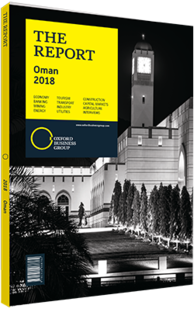Staying strong: Banks
The Omani banking sector comprises a total of 16 conventional banks, of which seven are locally incorporated and nine are foreign banks. Apart from conventional lenders, there are also two fully fledged Islamic banks. Bank Muscat is the largest bank with a market share of around 45% by assets. It is the biggest listed company on the Muscat Securities Market, with a market capitalisation of $2.8bn and one of the most dominant franchises in Oman with a large network of branches, clients and employees.
Attractive Prices
The weak macro environment in the sultanate has caused significant downward pressure on the stock prices of listed banks. Bank Muscat’s stock price is down by 41% from its peak in 2014, and trading at 400 baizas ($1.04) per share. The decline is mostly attributable to foreign selling as foreign investors have reduced their ownership from around 20% in 2014 to 12% currently. Foreign ownership and trading volumes in other listed banks in Oman remain low. Overall, stock prices of listed banks are now at attractive levels as they trade at a steep discount to regional peers and offer high dividend yields.
Despite share price weakness amidst a weak macro environment, the banking sector remains fundamentally strong given that it is meeting the regulator’s capital adequacy requirements as reflected by the Basel capital adequacy ratio of 16.8%. At the same time, the quality of bank assets has not witnessed any material deterioration as the delinquency rate is low.
During the first nine months of 2017, sector loans grew by 5.7% and deposits by 5.8% compared with the same period in 2016. Asset growth decelerated in 2017 due to lower demand for credit as business and consumers were cautious in the current macro environment. The aggregate earnings of the top-seven banks declined by 2.1% in the first nine months of 2017 due to pressure on interest spreads and a decrease in non-interest income. Liquidity, meanwhile, improved in 2017 as deposit rates have stopped climbing and hence banks’ cost of funds is stabilising. The Central Bank of Oman has ensured that there is enough liquidity in the system so that banks are not constrained to lend to various segments. The Omani government’s international borrowing in 2017 through a $5bn conventional bond and a $2bn sukuk (Islamic bond) has also helped improve liquidity in the market.
Growth of Islamic banks has outpaced conventional banking expansion. Total financing by Islamic banks and windows increased by 29% in the first nine months of 2017. Islamic deposits also recorded a 39% rise over the same time period. Islamic assets now account for 12% of the banking sector’s total.
Credit rating agency Moody’s downgraded the long-term local and foreign currency deposit ratings of the top-six banks in August 2017. The downgrade was underpinned by Moody’s view on the weakening fiscal capacity of the government to provide support to banks. However, it also noted that lenders maintain solid asset quality, healthy capital buffers and a relatively low market funding reliance.
To improve capital position, smaller banks in Oman raised capital during 2017 through perpetual bonds and rights issues. Oman Arab Bank, Ahlibank and Bank Sohar issued perpetual bonds of OR20m ($51.9m), OR50m ($129.8m) and OR100m ($259.7m) at coupon rates of 7.75%, 7.5% and 7.75%, respectively. The issues were well received by the market and were oversubscribed. The perpetual bonds offer a good investment opportunity for long-term investors as banks in Oman are well regulated and resilient to systemic risks.
Looking Ahead
The government’s diversification plan through the Tanfeedh programme and a rise in oil prices are expected to drive a pick-up in capital expenditure by both the government and the private sector. This will in turn lead to growth in banks’ lending activities to the manufacturing, tourism and logistics sectors, which have been highlighted in the Tanfeedh programme to diversify Oman’s economy.
You have reached the limit of premium articles you can view for free.
Choose from the options below to purchase print or digital editions of our Reports. You can also purchase a website subscription giving you unlimited access to all of our Reports online for 12 months.
If you have already purchased this Report or have a website subscription, please login to continue.

